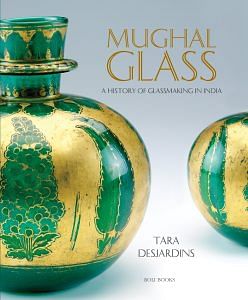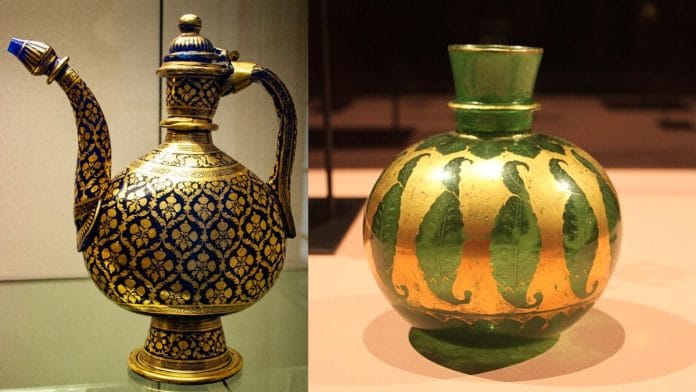In the late sixteenth century, a new empire encompassing much of North India and Pakistan emerged. This super-state, now known as the Mughal Empire, surpassed much of Europe in both wealth and power.
The Mughals were a Muslim dynasty from Central Asia who proudly traced their lineage back to Timur and Genghis Khan. They invaded the land of Hindustan in the early sixteenth century and established an empire that, at its greatest extent, stretched from Kashmir in the north to Mysore in the south.
Under their third emperor Akbar, the empire expanded to the western coast of Gujarat and eastwards to Bengal and included twelve royal subahs (provinces) spanning across much of North India.
Several types and centers of glass production were known to have existed during Akbar’s reign. One site was the town of Chandwar Nagar, later renamed ‘Firozabad’ after it was given to Akbar’s general, Firoz Shah, as a reward. While Firozabad is recognized today for crafting glass bangles and ‘block’ glass distributed to furnaces nationwide, during Akbar’s reign, this area – situated a mere 40 kilometers north of the imperial capital, Agra – manufactured a range of vessels intended for the court and local markets.
It was most probably glass from Firozabad that filled the rooms of Akbar’s royal treasury, which, according to European travelers’ accounts held ‘more than two million and a half rupees worth of the most elegant vessels of every kind in porcelain and colored glass.’ But the imperial capital also produced other kinds of glass.
The Ardhakathanaka – an autobiographical text of the Mughal poet Banarasidas (1586–1643), written during the reigns of Akbar, Jahangir, and Shah Jahan (completed in 1641) – lists glassblowers amongst its list of service occupations in Agra. Not only did Agra serve as the most important commercial center, the road connecting it to Fatehpur Sikri (Akbar’s capital from 1571–85) was also described as one continuous market where everything could be procured in the royal bazaars accompanying the camp, including glassware.
Also read: Why an East India Company job changed this family’s name from Sankalia to Killavalla
The most substantive reference to glass recorded during the early Mughal period appears in the Āīn-e Akbarī, the third part of the Akbarnama (The Chronicle or History of Akbar), the official chronicle of the emperor’s reign. Compiled in 1589 by his court historian, Abu al-Fadl ‘Allami, the Āīn-e Akbarī is dedicated to Akbar’s administration and rule.
Divided into five sections, the compendium offers detailed descriptions of the different administrative segments as well as occupations, including: the imperial household and royal ateliers; the division of the empire’s military and civil services; the imperial administration, including judiciary and executive departments, and land surveys; interpretations of social and religious customs, philosophy, and literature; and sayings of the Emperor, including his ancestry.
Explicit references to glass appear in two of the five sections, the first and the third. In the former, the section is organized into ninety ‘Ains (‘Regulations’), each of which deals with a different segment of administration or occupation and includes laborers’ wages and building materials, for example. Of these, mention of glass only appears towards the end of the section: in ‘Ain 86, ‘The Prices of Building Material’, glass is used for windows; in ‘Ain 87, ‘On the Wages of Laborers’, glass-cutters wages are given; and in ‘Ain 88, ‘On Estimates of House Building’, glass is mentioned with other materials needed to make windows.
In each, glass is synonymous with buildings and architecture. Curiously, it is not referenced within the list of royal ateliers associated with the court.
In the third section of the text, glass is mentioned in three of the twelve subahs: Bihar (northeast India) and Awadh (the modern state of Uttar Pradesh), while in the city of Alwar (in modern-day Rajasthan) ‘glass and woolen carpets are produced.’ In Awadh, glass is referenced within the context of traded goods, along with colored cloths, amber, salt, ornaments and earthen ware; whereas in Bihar, ‘gilded’ or ‘gilt’ glass (shisha-i zar afshan in the original Persian text) is manufactured. This text follows a brief description of houses, which are roofed and decorated with tiles, connecting glass, once again, with architecture.
While the term shisha-i zar afshan may refer to mica as opposed to glass – a mineral whose crystalline structure, when split or delaminated into thin sheets, could create a similar shimmering, or ‘gilded’ effect – the term more likely refers to ‘silvered’ glass globes, the traditional technique for mirror-making practiced in the Indian subcontinent for centuries and used to ornament buildings and embellish textiles.
Although ‘mirrors’ are not explicitly referenced within the Āīn-e Akbarī, free-blown glass globes lined with a mercury-tin mixture may, in fact, be the type of ‘gilded’ glass Abu al-Fadl ‘Allami describes in reference to glass produced in Bihar, making mirrors some of the earliest examples of glassblowing practiced in Mughal India. Examples of mirrors used within an architectural context can be dated to this period.
 This excerpt from ‘Mughal Glass: A History of Glassmaking in India’ by Tara Desjardins has been published with permission from Roli Books.
This excerpt from ‘Mughal Glass: A History of Glassmaking in India’ by Tara Desjardins has been published with permission from Roli Books.






